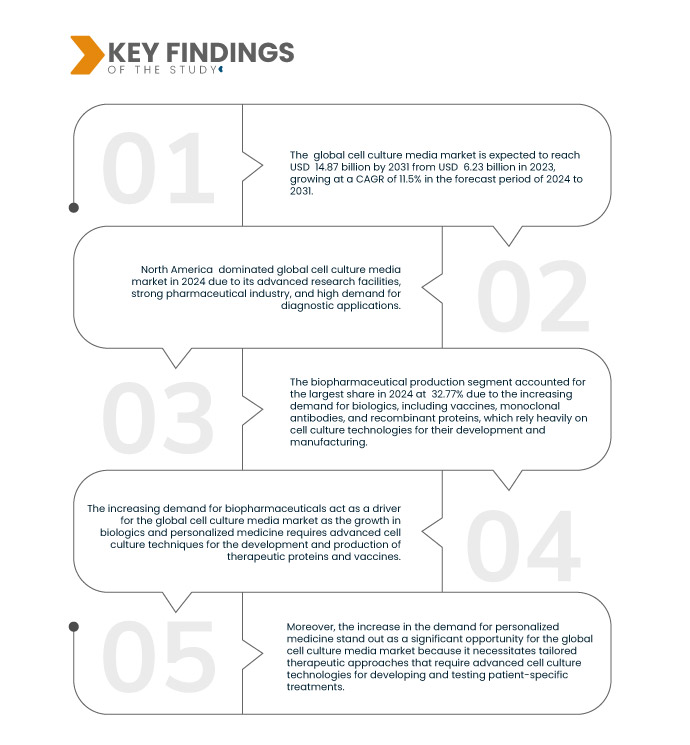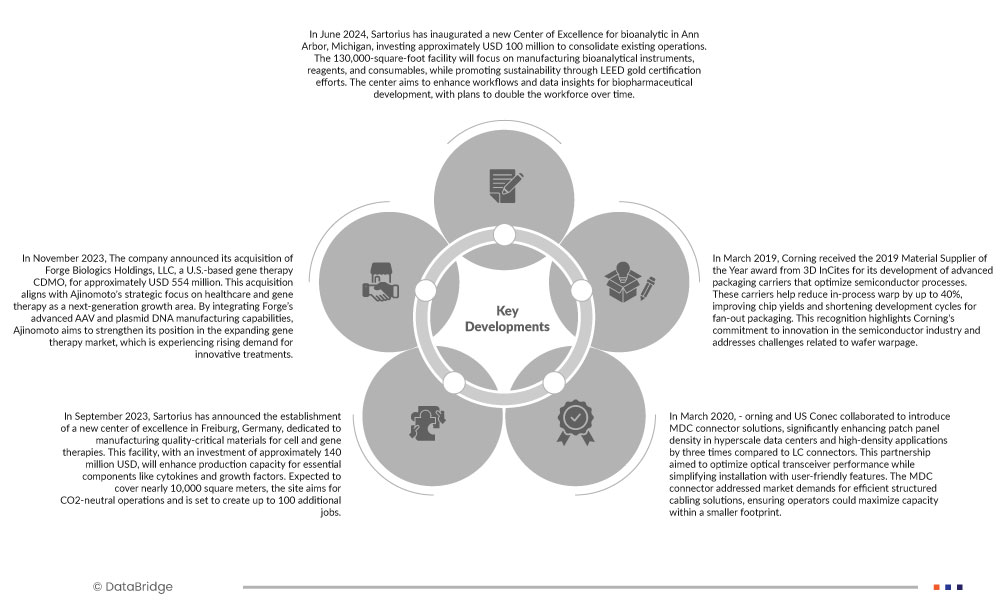The increasing focus on personalized medicine is driving the growth of the global cell culture media market. With personalized medicine, patients receive customized treatment plans based on their unique genetic profiles and disease characteristics. This requires the use of high-quality cell culture media that can support the growth of specific cells or cell types, driving demand for specialized cell culture media.
For Instance,
- In March 2023, according to an article in National Library of Medicine, the development of new technologies has accelerated the growth of personalized medicine. The benefits of personalized medicine ranges from improving diagnostic accuracy, reducing side effects, allows for better disease prevention, and most importantly, increases patient engagement, reduces healthcare costs, and also promotes research and innovation
Personalized medicine relies on the discovery of biomarkers that can predict disease risk, progression, and treatment response. Cell culture media plays a crucial role in biomarker discovery, enabling researchers to grow and analyze specific cells or cell types. This drives demand for advanced cell culture media that can support the growth of complex cells or cell lines. Furthermore, the increasing use of gene therapy and stem cells in personalized medicine is also driving demand for cell culture media.
For Instance,
- In March 2023, according to an article ‘Applications of Stem Cells in Personalized Medicine’, novel applications of stem cells drive personalized medicine, tailoring treatments to each patient's need. This ensures that treatments are effective and reduce potential side effects allowing interventions to be more unique
Access Full Report @ https://www.databridgemarketresearch.com/de/reports/global-cell-culture-media-market
Data Bridge Market Research analyzes that the Global Cell Culture Media Market is expected to grow at a CAGR of 11.5% in the forecast period of 2024 to 2031 and is expected to reach USD 14,873.56 thousand by 2031. The devices segment is projected to propel the market growth due to the increasing demand for advanced monitoring.
Key Findings of the Study
GROWING ADOPTION OF CELL CULTURE MEDIA
The global cell culture media market encompasses the production, distribution, and utilization of specialized media designed for culturing cells in laboratory and industrial settings. This market is experiencing significant growth due to the rising demand for biopharmaceuticals, advancements in cellular research, and expanding applications of cell culture in fields such as drug discovery, regenerative medicine, and vaccine development. It offers a wide range of products, including classical media, serum-free formulations, and specialty media tailored to specific cell types and research requirements. The market is shaped by a diverse network of stakeholders, including manufacturers, suppliers, and research institutions, and is driven by technological innovations, evolving regulatory landscapes, and the global burden of chronic diseases.
Additionally, the growing emphasis on personalized medicine has spurred innovation in cell culture media, with companies focusing on advanced formulations and cutting-edge technologies to support the cultivation of specific cell types. These advancements include the development of highly specialized media, innovative equipment, and modern manufacturing techniques. As personalized medicine continues to gain traction, the demand for innovative cell culture solutions is expected to propel the growth of this market further
Report Scope and Market Segmentation
|
Report Metric
|
Details
|
|
Forecast Period
|
2024 to 2031
|
|
Base Year
|
2023
|
|
Historic Year
|
2022 (Customizable to 2016 – 2021)
|
|
Quantitative Units
|
Revenue in USD Thousand, and Pricing in USD
|
|
Segments Covered
|
Type (Chemically Defined Media, Classical Media, Serum-Free Media, Specialty Media, Stem Cell Media, Lysogeny Broth (LB), Custom Media Formulation, and Others), Application (Biopharmaceutical Production, Drug Screening & Development, Diagnostics, Regenerative Medicine & Tissue Engineering, and Others), End-User (Biopharmaceutical Companies, Biotechnology Organizations, Academic and Research Laboratories, Hospitals, Diagnostic Centers, Cell Banks, Forensic Laboratories, and Others), Distribution Channel (Direct Tenders, Third Party Distribution, and Retails Sales)
|
|
Market Players Covered
|
Thermo Fisher Scientific Inc. (U.S.), Merck KGaA (Germany), Danaher Corporation (Cytiva) (U.S.), Corning Incorporated (U.S.), and Sartorius AG (Germany) among others
|
|
Data Points Covered in the Report
|
In addition to the insights on market scenarios such as market value, growth rate, segmentation, geographical coverage, and major players, the market reports curated by the Data Bridge Market Research also include depth expert analysis, patient epidemiology, pipeline analysis, pricing analysis, and regulatory framework.
|
Segment Analysis
The global cell culture media market is segmented into four notable segments based on type, application, end use, and distribution channel
- On the basis of type, the market is segmented into chemically defined media, classical media, serum-free media, specialty media, stem cell media, lysogeny broth (LB), custom media formulation, and others
In 2024, the chemically defined media segment of the test type segment is expected to dominate the market
In 2024, the chemically defined media segment is expected to dominate the market due to the increasing awareness about early detection and the affordability and accessibility of home-based kits. This segment is expected to dominate the market with a market share 27.19%.
- On the basis of application, the market is segmented into Biopharmaceutical Production, Drug Screening & Development, Diagnostics, Regenerative Medicine & Tissue Engineering and Others
In 2024, the biopharmaceutical production segment of the type segment is expected to dominate the market
In 2024, the biopharmaceutical production segment is expected to dominate the market due to their ease of use, low cost, and quick results. This segment is expected to dominate the market with a market share of 32.77%.
- On the basis of end user, the market is segmented into biopharmaceutical companies, biotechnology organizations, academic and research laboratories, hospitals, diagnostic centers, cell banks, forensic laboratories and others.
In 2024, the biopharmaceutical companies segment of the type segment is expected to dominate the market with a market share of 39.51%
- On the basis of distribution channel, the market is segmented into direct tenders, third party distribution and retails sales
In 2024, the direct tenders segment is expected to dominate the market with a market share of 50.68%.
Major Players
Data Bridge Market Research Analyses Thermo Fisher Scientific Inc. (U.S.), Merck KGaA (Germany), Danaher Corporation (Cytiva) (U.S.), Corning Incorporated (U.S.), Sartorius AG (Germany) as major market players in this market.
Market Development
- In September 2024, Merck has achieved industry-first EXCiPACT cGMP certification for Pharmaceutical Auxiliary Materials at its global cell culture media production sites in Germany, the UK, China, and the USA, ensuring high safety and quality standards for essential raw materials in biomanufacturing
- In September 2024, Cytiva has opened its first Innovation Hub in Songdo, Incheon, Korea, featuring a manufacturing facility and customer experience lab. Set to enhance biopharmaceutical manufacturing, the hub aims for sustainable practices and collaboration, supporting growth in the APAC life sciences industry
- In May 2023, Thermo Fisher and BRIN have partnered to enhance research capabilities in Indonesia, focusing on advancing scientific innovation and collaboration in life sciences, biotechnology, and environmental studies for local researchers
Regional Analysis
Geographically, the countries covered in the market are U.S., Canada, and Mexico, Germany, U.K., Italy, France, Spain, Switzerland, Russia, Turkey, Belgium, Netherlands, rest of Europe, Japan, China, South Korea, India, Australia, Singapore, Thailand, Indonesia, Malaysia, Philippines, rest of Asia-Pacific, Brazil, Argentina, rest of South America, South Africa, Egypt, Saudi Arabia, U.A.E., Israel, and rest of Middle East and Africa.
As per Data Bridge Market Research analysis:
North America is expected to be the dominating region and Asia-Pacific is the fastest growing region in the market
North America is expected to dominate the market due to advancements in R&D technology and a presence of key players, surge in R&D expenditure.
Asia-Pacific is expected to be the fastest growing due to the region's rapidly increasing population. government initiatives and investments aimed at biopharmaceutical industries, along with increasing development of vaccine, are contributing to the market's expansion.
For more detailed information about the Global cell culture media market report, click here – https://www.databridgemarketresearch.com/de/reports/global-cell-culture-media-market














